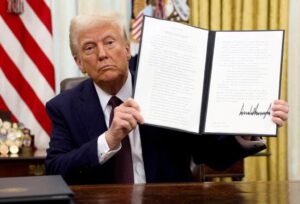Trump says “Fed would be much better off cutting interest rates.”
Former President Donald Trump’s recent statement urging the Federal Reserve to cut interest rates aligns with his longstanding criticism of the central bank’s policies. Here’s a structured analysis of the implications and context:
1. Context of Trump’s Statement
– *Historical Precedent: Trump frequently criticized the Fed during his presidency, mainly targeting Chair Jerome Powell for raising rates, which he argued slowed economic growth. His latest remarks continue this pattern, emphasizing his preference for low rates to stimulate economic activity.

– *Political and Economic Timing*: If made during an election cycle or amid economic uncertainty, Trump’s push for rate cuts could reflect a desire to boost short-term economic performance, influencing voter sentiment.
2. The Federal Reserve’s Role and Independence
– *Mandate*: The Fed operates independently to balance its dual goals of maximum employment and stable inflation (targeting 2%). Political pressure risks undermining this independence, which is crucial for maintaining credibility in monetary policy.
– *Current Economic Conditions*: As of 2023, the Fed has raised rates aggressively to combat high inflation. Cutting rates prematurely could risk reigniting inflationary pressures, whereas maintaining high rates might slow growth. The Fed’s decisions depend on data, not political directives.
3. Pros and Cons of Rate Cuts
– *Potential Benefits*:
– *Economic Stimulus*: Cheaper borrowing could boost business investment, consumer spending (e.g., mortgages, auto loans), and equity markets.
– *Debt Servicing Relief*: Lower rates reduce government debt costs, a significant factor given the U.S.’s elevated debt levels.
– *Risks*:
– *Inflation*: Cutting rates while inflation remains above target could de-anchor expectations, making inflation harder to control.
– *Asset Bubbles*: Excessively loose policy might fuel speculative investments in real estate or stocks.
4. Political Implications*
– *Election Influence*: Presidents often seek strong economies ahead of elections. Trump’s push may aim to preemptively assign blame if economic conditions worsen or claim credit if the Fed pivots.
– *Fed Independence Concerns*: Economists and institutions (like the Brookings Institution) warn that politicizing monetary policy could lead to short-termism and erode public trust in the Fed.
5. Historical Precedents*
– *Nixon-Era Pressure*: President Nixon pressured Fed Chair Arthur Burns to cut rates in the early 1970s, contributing to stagflation. This serves as a cautionary tale against political interference.
– *Trump vs. Powell (2018–2020)*: Trump’s public attacks on Powell for rate hikes and later praise for pandemic-era cuts highlight the contentious relationship.
6. Market and Expert Reactions*
– *Investors*: Markets might initially rally on rate-cut expectations, but prolonged political pressure could raise concerns about policy credibility.
– *Economists*: Most argue the Fed should maintain autonomy. For example, former Fed Chair Ben Bernanke has stressed that central banks must resist short-term political pressures to ensure long-term stability.
Conclusion
Trump’s advocacy for rate cuts reflects his preference for stimulative policies but risks conflating political objectives with sound economic stewardship. While lower rates could offer short-term economic benefits, the Fed’s data-driven approach remains critical to avoiding inflationary relapse or market instability. The broader concern is preserving institutional independence, which has historically been pivotal to maintaining economic resilience.









